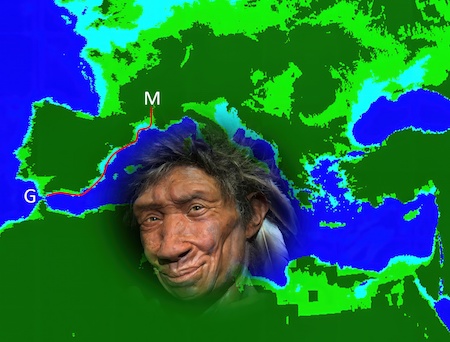A scientific paper which has just been published as a bioRxiv preprint reveals a hitherto unknown connection of this important Neanderthal.
The paper entitled “A late Neanderthal reveals genetic isolation in their populations before extinction” by an international team led by French archaeologist Dr Ludovik Slimak reports the discovery of a late Neanderthal individual, nicknamed “Thorin”, from Grotte Mandrin in Mediterranean France, and his genome. Thorin is associated with a rich archaeological record of the last Neanderthals in the region of the Rhone Valley ~50-42 thousand years ago.
The surprise came when analyses of the mitochondrial genome showed that Thorin was genetically closer to “Nana”, the nickname given to the Gibraltar 1 skull from Forbes’ Quarry in 1848, than to any other known Neanderthal. This revelation threw everyone by complete surprise – Thorin was closer to Nana than even to the western European Neanderthals who were geographically closer to him. The genetic relationship observed between Thorin and Nana indicates that the Gibraltar Neanderthals were members of an extended southwest European population, one that was isolated from the classic Neanderthals and which held out in pockets until their final disappearance.
Commenting on the findings, Professor Clive Finlayson expressed his delight. “I have known about this since the autumn when Dr Slimak and a French television crew visited Gibraltar. They run an interview between us as part of a documentary that was in preparation. But I had to remain tight-lipped as the results had been revealed to me confidentially, prior to publication.” Professor Finlayson added “This is so exciting. Here we have evidence of an apparent isolation between certain late groups of Neanderthals from the mainstream western European population. The Gibraltar Neanderthals were more closely connected to those from Mediterranean France than to those from western Europe, some of whom probably lived closer to Gibraltar than Thorin, and they seem to have been part of a late surviving and fragmented population. This raises many questions, some of which I have been pondering for months, and which is going to open up fantastic new avenues of research and collaboration.”
Minister for Heritage, the Hon Prof John Cortes said, “The information on Neanderthals that is being gathered in recent years is fascinating, and gives a real insight into European prehistory. The work led by the Gibraltar National Museum at Gorham’s Cave Complex World Heritage Site is key to this proliferation of knowledge. I am sure that we are all justly proud of Gibraltar’s contribution in this field.”
The paper is available online: https://www.biorxiv.org/content/10.1101/2023.04.10.536015v1
The image is a map of Europe which shows the location of Mandrin Cave in France (M) and Gibraltar (G). Land exposed by lowered sea levels, which would have opened up a coastal route between the two sites during cold periods, is shown in light blue and the red line shows the possible connection of these populations, disconnected from the rest of mainland Europe. The face is of the forensic reconstruction of Nana by Kennis & Kennis, on display in the Gibraltar National Museum.
